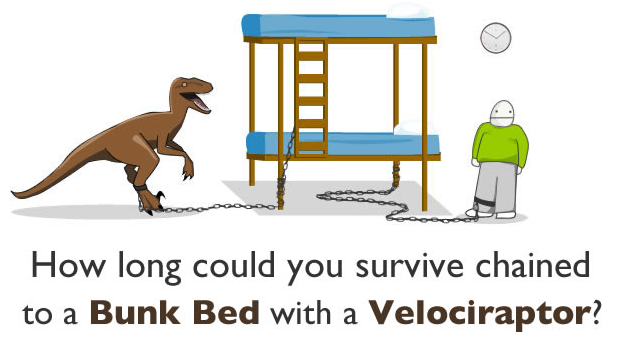
Infographics are Dead. Long Live Infographics.
This YouMoz entry was submitted by one of our community members. The author’s views are entirely their own (excluding an unlikely case of hypnosis) and may not reflect the views of Moz.
Understanding the Lifecycle of Content Mediums
Following Panda and Penguin, the majority of the digital marketing industry jumped on the bandwagon and embraced “quality content” as its messiah. Everyone finally gets it: Success depends on your ability to create great things.
But, there is a context to the business of doing “content marketing,” including nuances that must be understood if long-term success is to be achieved. There’s a clear life cycle of innovation and saturation in the evolving content landscape -- understanding and leveraging this cycle can make all the difference in the success of your campaigns.
Below is a brief individual perspective on how I've seen popular content mediums evolve over the last five or six years, and why I feel this evolution is so important to track. I believe that through our study of this evolution, we can find some of the best opportunities available to us as marketers.
Step One: A New Medium Gains Popularity
Over the past few years, we’ve seen a variety of content mediums surge in popularity. While not necessarily the first of their kind, the emergence of a trending content medium is apparent when it becomes massively shared for the first time or when its potential as a marketing tool becomes widely recognized and it starts being copied. Below are some obvious examples of content mediums that have been wildly popular in recent years.
“Top X” lists & Viral Articles
While still a very popular format, there was a time when “Top X” lists ruled social aggregators like Digg and Reddit. As a medium, lists get straight to the point. They’re not only easily consumed, but those which are successful are more often than not also funny, timely or enlightening in some way.
For early adopters like Cracked.com, who harnessed this emerging medium and the traffic engines behind it, massive success became almost formulaic.

[Source]
Widgetbait
Top X lists and other content written for virality were at the genesis of so-called “linkbait,” or content created with the specific intent of generating inbound links. Taking the idea a step further, widgetbait became one of the first interactive/programmatic incarnations of “linkbait,” providing a highly effective means of generating links.

Quizbait
Quizbait evolved alongside of, and is similar to widgetbait, but its format is slightly different. While still giving the user a badge or widget to display on their blog or website (often with an embedded link), quizbait is often designed to appeal to the individual user’s personality and vanity.
Matt Inman, the genius behind some of the web’s first widgetbait, also harnessed quizbait to build the base that solidified Theoatmeal.com as one of the foremost cartoon and humor sites on the web.

[Source]
Infographics
Infographics began to emerge as a popular content medium in 2009, again gaining their initial ground on social sharing and voting websites. Since then, their popularity has exploded. As highly visual elements that are easy to consume, infographics have become popular from the publisher perspective, as well as the audience perspective.
Step Two: The New Medium Is Heavily Leveraged
In online marketing, as in every industry, there exist a subset of early adopters. Sometimes these early adopters are the innovators themselves, but often they’re simply students of digital trends. These people not only have a keen eye for emerging trends that have stickiness, but also recognize opportunities to capitalize on that stickiness.
The diffusion of innovation theory gives us a framework to understand the adoption of new innovations. The marketers who move through the five-step innovation process quickest are poised to reap the most reward.
.jpg)
By keeping their thumb on the pulse of marketing trends, early adopters are some of the first to become aware of new content mediums. Their continued tracking of trends leads to quick persuasion and the drawing of conclusions about the potential of new mediums and new marketing tools. Through experimenting with these new technologies, forward-thinking marketers are able to reject or accept the feasibility and ultimate potential of new mediums quickly -- moving on or fully leveraging new innovations practically in real time.
Step Three: The New Medium Becomes Ubiquitous
Over time, more and more people come not only to understand the power of certain content mediums, but find ways to create their own content within those mediums. Businesses form to help bridge the gap and the new medium begins to saturate the market over time.
Recognizing this crucial turning point is very important for content marketers because it signals a decline in the potential ROI of that particular medium.
Step Four: People Tire of the New Medium
As new content mediums approach saturation, interest wanes significantly. Slowly but surely, people become overwhelmed and any novelty the medium once held has disappeared. At the stage of oversaturation, content has nothing to stand on beyond its intrinsic merit. Iteration on the content itself (as well as the medium) becomes key.
Industries that allow for small innovations with lots of experimentation and tracking can serve as a microcosm for studying this phenomenon. The decline of banner/display advertising is an excellent example of how oversaturation can lead to blindness and decreasing returns. But, it also helps make clear that when innovation is necessitated within such an ecosystem, the experimenter and innovator can reap impressive rewards.
Marketers make a huge mistake when they fail to realize oversaturation of a medium has taken place, if they aren’t simultaneously working to iterate on the medium to keep aspects of it fresh. It is the iteration and experimentation within content mediums that allow new types of content to emerge, but it also prevents content mediums from dying a quick death.
Iteration and experimentation has always been a hallmark of the SEO community. Just because we’ve entered a content-focused world, doesn’t mean there’s not just as much (if not more) opportunity for the analytical, quantitative, experimentally focused mind. It’s not just the creative types who will be successful in this world. For the left-brained among us, testing and tracking content types across the web, and introducing a process for measuring and evaluating individual content penetration metrics will lead to the data necessary for continued success.
Those aspects of our industry which are easily primed for tracking and analysis, also tend to be the most experimented with and iterated upon. As we mentioned, paid and display advertising fall into these categories -- but content can as well.
The content creation process must follow a process and have a methodical and driving force to corral creative energy and ideas.
Step Five: Late Adopters Fail to Capitalize on the Medium’s Novelty
The novelty of a medium has a boosting effect on the content you create. If you’re one of the first to utilize a new medium effectively, you have a major leg up. The actual intrinsic quality of the message doesn’t need to be as good because you’ve got the novelty of the medium to bolster you.
Once the novelty of a medium wears off, there’s a risk of looking like a “me too” marketer. In other words, if you fail to continuously innovate, you’re stuck in a position where it’s obvious that you’re milking the golden cow for all it’s worth. Or even worse, you wait so long that you only jump on the bandwagon as it’s falling apart.
Step Six: The Medium (Hopefully) Retains Value
Over time (typically a year or two), the new medium has lost most of its original novelty. If it truly offers an alternative way for people to consume data and information, it will continue to be viable far into the future. In this case, it can become a tool (though perhaps not the primary tool) in your arsenal as a content marketer.
At this stage, you’ve completely lost that spark which allows a decent message to achieve godlike exposure. Without that novelty, you’re reminded that great content must always provide most of its value through its message.
Step Seven: Resurrection and Reincarnation of the Content Medium
Of course, like any trend or fad, even marketing innovations can come back into style. Often times, iterations that introduce new novelty to a medium will emerge. This can breathe new life into the medium and re-energize it.
Content mediums are also revitalized as new technologies and design trends enable innovative marketers to take once popular formats and take them a step further, or that allow once independent mediums to enjoy resurging popularity through their melding.
Looking at just information design and IG’s as a medium, this type of rapid evolution and re-imagining becomes clear:
- Indexable Infographics (IGs + Articles)
- Motion Graphics & Kinetic Typography (IGs + Video | Animation)
- Interactive IGs (IG + Animation + Scripting)
- Scribe Videos (Live drawing with IG features & cartoonification)
- Parallax Visualization (IG + JS/Parallax + Mixed Media)
- Mixed Media Long Form Articles (IG features, Mixed Media, Interactive Elements)
The Cycle Begins Again
Beyond the resurrection or reincarnation of a content medium, completely new mediums will continue to arise, typically stemming from:
- An emergent new technology that allows for a new type of innovation
- A cultural or social shift or naturally arising meme gives birth to a new medium
New web browser technologies related to WebGL, and other cutting edge capabilities of HTML5 are giving us the power to create richer and deeper interactive experiences in a highly accessible way. The growth of these standards and the increasingly powerful capabilities of Javascript in the browser are opening the door for interactive visual styles that couldn’t have been imagined in the recent past.
The sharing culture of social media is also pumping out new meme-based content mediums, and revitalizing traditional ones. The explosion of this is an excellent example of this evolution.
Emerging Technologies
Being an early adopter or innovator isn’t easy, which is precisely why there is so much to be gained from taking the steps to experiment in uncharted territory.
When new mediums do emerge, marketers quickly become inspired by the possibilities these new mediums hold -- and often are misled to over-inflate the intrinsic value of the content itself (it’s message), focusing instead on the boost the content is given based on its novel method of delivery. Over time, barriers to entry lower, which leads to an influx of new content utilizing these new techniques.
Take advantage of the rocket fuel that is novelty, but realize where its power ends. Be the one to systematize and harness the power of new mediums. Remember that each new viable medium will retain value as a tool in your arsenal in the long-term, but reinvention and combination can resurrect even the most saturated techniques.
And never forget, the quality of your message matters most. Your content’s message must still resonate if you hope to retain long-term value from your marketing endeavors. It doesn’t matter how beautiful the wrapping paper is if the present is a piece of crap.




Comments
Please keep your comments TAGFEE by following the community etiquette
Comments are closed. Got a burning question? Head to our Q&A section to start a new conversation.